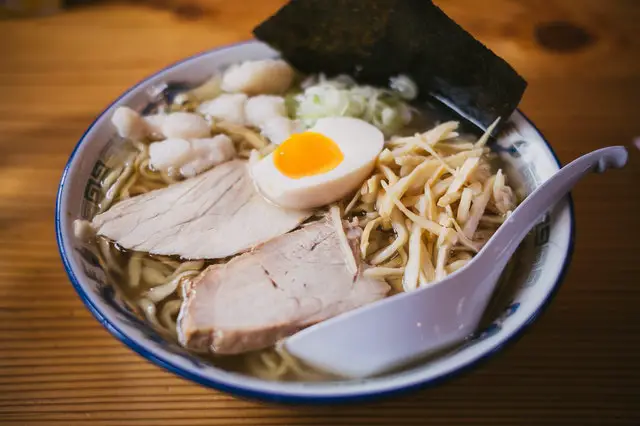Ramen may be an unfamiliar term. But you’ve likely eaten it or seen long lines at Japanese noodle restaurants and wondered what everybody is waiting for.
Keep reading to learn more about Ramen. Then consider if you’ll make some yourself or try some authentic Ramen at a restaurant this week.
Here are 20 questions and answers that will give you everything you need to know about Ramen!
1. What is Ramen?
Ramen is a type of Japanese noodle soup. It will come with either Chinese-style wheat noodles or sometimes egg noodles. The broth in Ramen is rich in flavor, with a meat or fish base. You’ll then have the option to add various meats and vegetables to your soup.
2. Where did Ramen come from?
Ramen is considered Japanese food, but it likely originated in China and traveled to Japan via immigrants around 1859. Ramen first appeared in Japan in the Yokohama Chinatown and spread throughout Japan from there.
3. Where did the name Ramen come from?
Ramen is derived from the Chinese word lamian 拉面. Lamian is the name of a type of Chinese noodle.
4. Are there different types of Ramen?
Ramen has spread throughout Japan, and most chefs try to make their own version of it or add some kind of spin to make it more interesting or innovative. However, there are four main types of Ramen on which all other Ramens are based. The base soup in the Ramen is what differentiates them.
- Shio (salt-based)
- Shoyu (soy sauce based)
- Miso (soybean paste based)
- Tonkotsu (pork bone broth-based)
5. Is there a special way you need to eat Ramen?
Once your Ramen is served, you must eat it fast. If you let the Ramen sit for too long, it can turn mushy and soft. Therefore, finishing your Ramen within 10 minutes is expected.
Slurp your noodles, don’t worry about the noise. The noise shows appreciation for the food, and it also aerates the noodles to give them extra flavor.
6. Is Ramen healthy for you?
Eating most things in moderation is fine. However, Ramen does not fall into the healthy category. It’s a delicious dish that you should enjoy but not too often. Be especially careful if you are eating instant Ramen noodles.
Ramen can have extremely high levels of salt, MSG, and TBHQ which all have adverse effects on your health if consumed in high amounts.
That being said, Ramen can have many nutritious, and healthy components added.
7. Does Ramen taste sweet, salty, sour, or bitter?
Ramen flavor profile is Umami, which is a lesser-known sensation for your mouth. Umami means the essence of deliciousness. It’s described as meaty and savory and is just a plain delicious flavor.
8. Is Ramen expensive?
Ramen comes in two very different varieties. You can buy Ramen from a restaurant that is as expensive as the restaurant sees fit to make it, so the price can range significantly.
Most Ramen restaurants are small and offer reasonably priced and even cheap options for their Ramen dishes.
You can also buy instant Ramen from most grocery stores. Instant Ramen is so cheap that you could eat it for breakfast, lunch, and dinner for an entire year and only spend about US$ 140.
9. Is Ramen luxury food or cheap college food?
Ramen was originally a luxury simply due to price. However, as times have changed, Ramen has become much cheaper for anybody and is now widely available.
One of Ramen’s biggest markets now is college students that need cheap food. They may not even know it’s Ramen and just consider it to be instant noodles.
10. Are all instant noodles considered Ramen?
Purists may not believe that any instant noodles are really Ramen. But as far as marketing goes, not all instant noodles are Ramen.
Instant noodles are simply a quick and convenient dried noodle dish that you can make at home. Ramen is a type of noodle that is used in some instant noodle products.
11. Why is Ramen so popular?
Ramen is a cheap option with great marketing and tastes delicious. With the small footprint of the restaurants and the easily accessible home versions, most consumers have tried it even in the West.
Another reason for the popularity is that you can add absolutely anything you want to the dish to meet your specific tastes.
12. Which country eats the most Ramen?
Ramen is a Japanese dish, but China is the biggest consumer of it. Chinese people eat around 40 billion servings of Ramen a year.
This is likely just because Ramen is so popular and has reached almost all countries. And China happens to have a lot of people.
13. Is Ramen vegetarian?
Ramen noodles are made from simple ingredients: hot water, kansui, salt, and wheat flour. So there is no meat or animal products included in the actual noodle of traditional Ramen.
However, the broth and other additions to the soup may contain meat, so it’s something you need to check before consuming.
14. Why are Ramen noodles yellow?
Ramen doesn’t get its yellow color from egg, and there should be no egg mixed with Ramen noodles.
The yellow color comes from the kansui, which is alkalized water that causes a chemical reaction, making the noodles yellow.
15. How long are Ramen noodles?
The length of a Ramen noodle depends on the chef. However, instant Ramen noodle packets contain around 51 meters of noodles.
16. Do you have to cook Ramen?
Instant Ramen noodles do not need to be cooked, and many people will eat them as a crunchy snack. There is nothing wrong with eating the noodles. However, the dry noodles may absorb the liquids in your stomach, so overeating dried noodles may cause problems.
You probably won’t enjoy fresh Ramen noodles unless you cook them though.
17. How much would it cost you only to eat Ramen?
If you only eat instant Ramen noodles for breakfast, lunch, and dinner, it would only cost you $140 or less per year, which is part of the draw to college students and people on a budget. However, the big issue is that they do not contain protein or any real nutritional value.
18. What was the first type of noodle eaten in space?
You can probably guess that it was Ramen. The inventor of instant noodles created a special Ramen instant noodle that could be consumed in space, called Space Ram.
In 2005, Japanese Astronaut Mr. Soichi Noguchi carried the noodles into space and was the first to eat Ramen noodles in space.
19. Why don’t Ramen noodles get soft and fall apart?
Ramen noodles can become softer if left in their broth for too long. However, there are a few steps in Ramen preparation that causes them to stay firmer.
First, Ramen noodles are often cooked and then placed in cold water to stop the cooking process. They are then placed into the broth, where they are heated back up. Controlling the cooking process allows the noodles to stay firmer for longer.
Some Ramen noodles also have a higher protein content, which means they are less absorbent and remain firmer due to not taking on so much water.
20. Is Ramen easily digested?
Ramen, in general, is not easy to digest and may take many hours for your stomach acids to break down. There is often a special preservative in the noodles called TBHQ, which your stomach has difficulty breaking down. So noodles can stay whole in your stomach for many hours after eating them.
Final Thoughts on Ramen
There are two very different types of Ramen, fresh that you get at restaurants and can even make at home if you can find the fresh noodles at specialty stores.
On the other hand, you have instant noodles, which is an extremely cheap option that can be used by itself, or you can add your fresh ingredients to the broth you make.
Whatever the case, Ramen has become an extremely popular dish available worldwide and is most often cheap even when purchased at a restaurant.




